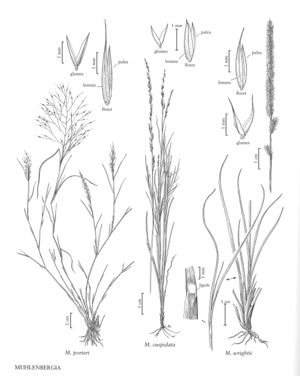Muhlenbergia porteri
Plants perennial; loosely cespitose from a knotty base, not rhizomatous, distinctly bushy in appearance. Culms 25-100 cm tall, 0.5-1.5 mm thick, erect, geniculate, wiry, freely branched, branches stiff, geniculate, widely divergent; internodes scabridulous throughout. Sheaths shorter than the internodes, glabrous; ligules 1-2.5 (4) mm, truncate, lacerate, with lateral lobes; blades 2-8 cm long, 0.5-2 mm wide, flat or folded, smooth or scabridulous abaxially, scabridulous adaxially. Panicles 4-14 cm long, 6-15 cm wide, open, not dense, usually purple; primary branches 1-7.5 cm, diverging 30-90° from the rachises, stiff, naked basally; pedicels 2-13 (20) mm, scabrous. Spikelets 3-4.5 mm. Glumes 2-3 mm, shorter than the lemmas, 1-veined, veins scabrous, apices gradually acute to acuminate, occasionally mucronate, mucros to 0.4 mm; lemmas 3-4.5 mm, lanceolate, purplish, appressed-pubescent on the lower 1/2 - 3/4 of the margins and midveins, apices acuminate, awned, awns 2-13 mm, straight; paleas 3-4.5 mm, lanceolate, acuminate; anthers 1.5-2.3 mm, purple to yellow. Caryopses 2-2.4 mm, oblong, compressed, yellowish-brown. 2n = 20, 23, 24, 40.
Distribution
Okla., N.Mex., Tex., Utah, Calif., Colo., Ariz., Nev.
Discussion
Muhlenbergia porteri grows among boulders on rocky slopes and on cliffs, and in dry arroyos, desert flats, and grasslands, frequently in the protection of shrubs, at elevations of 600-1700 m. Its geographic range extends from the southwestern United States to northern Mexico.
Muhlenbergia porteri is highly palatable to all classes of livestock, but is never abundant at any particular location.
Selected References
None.
Lower Taxa
"decumbent" is not a number.
